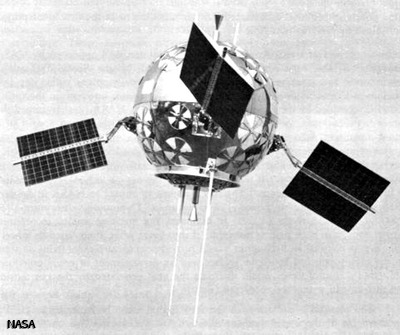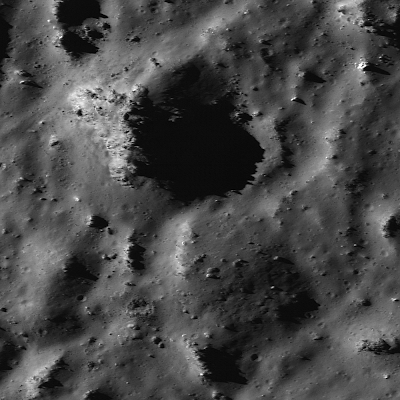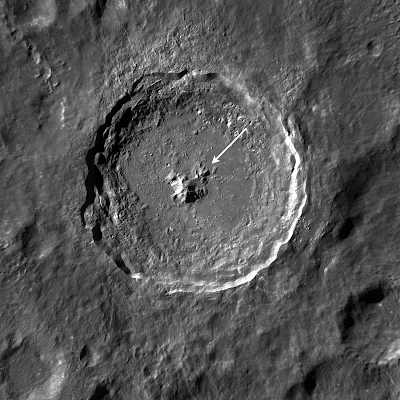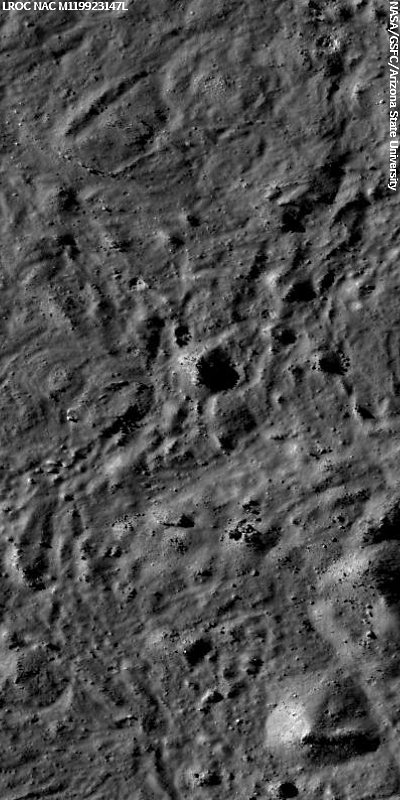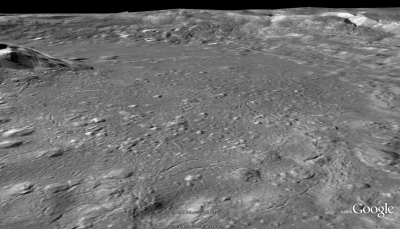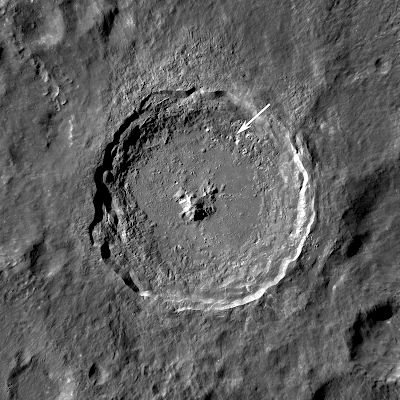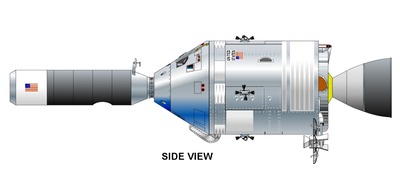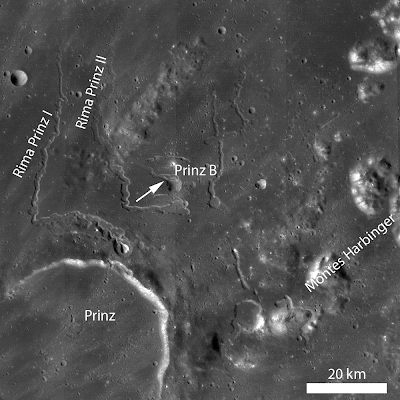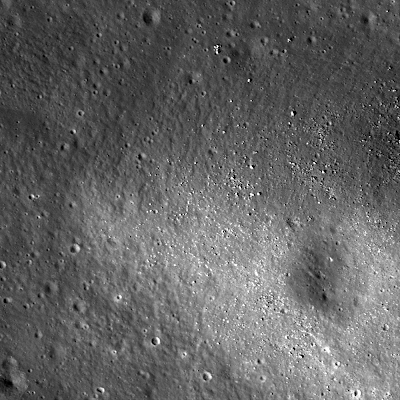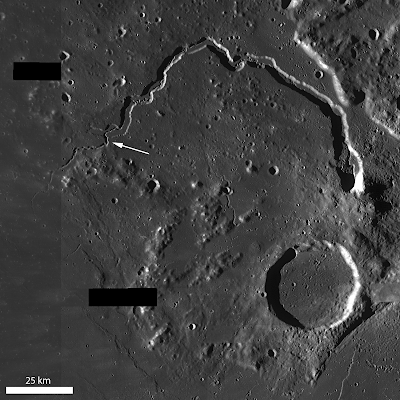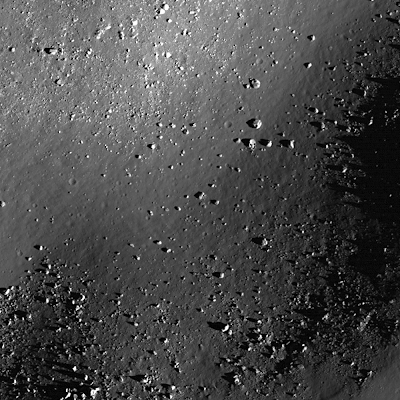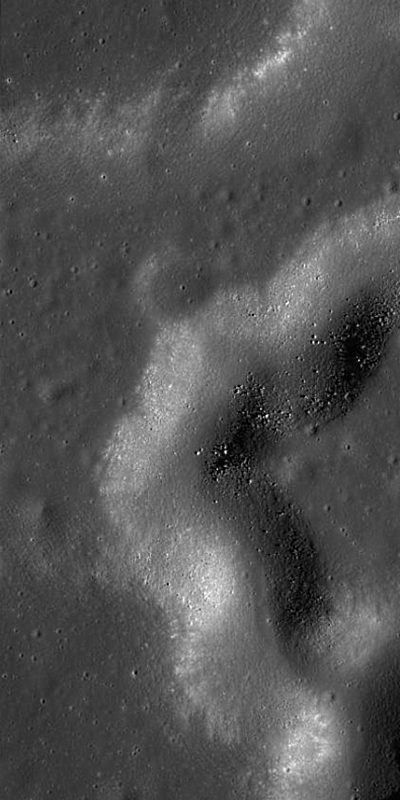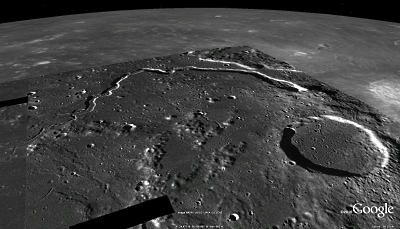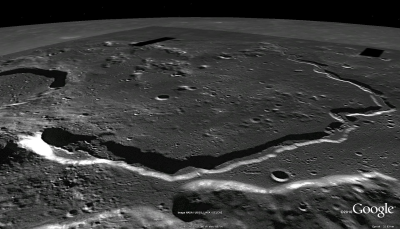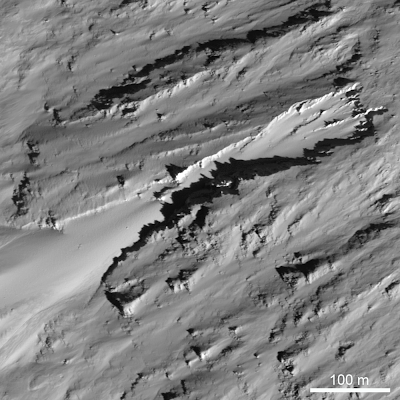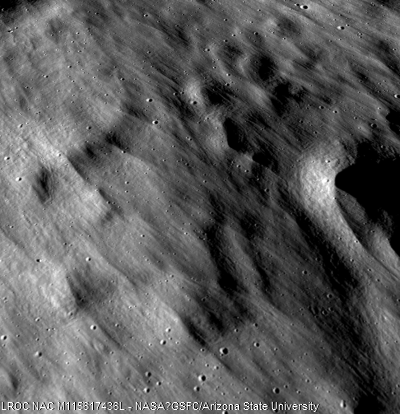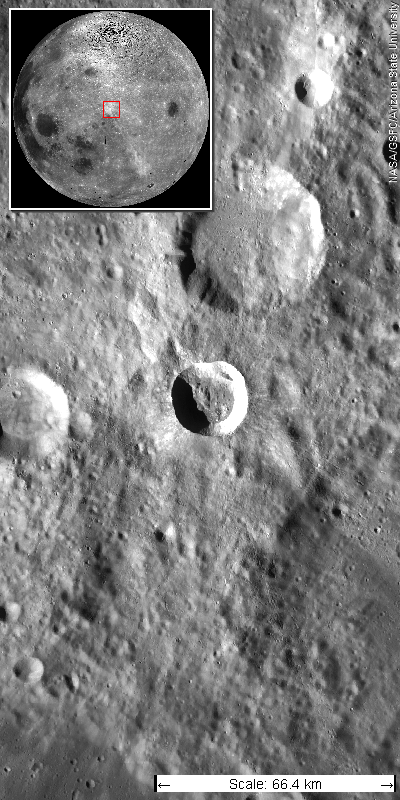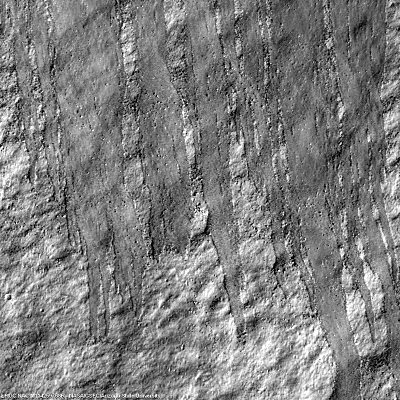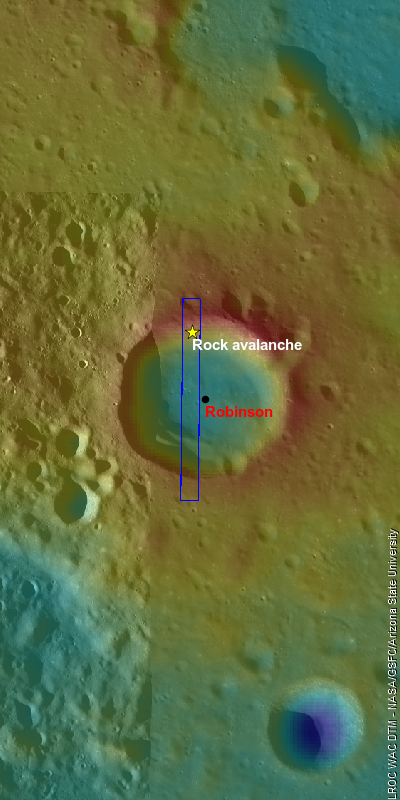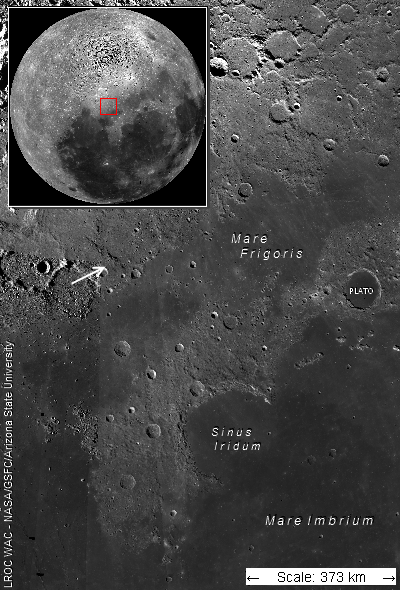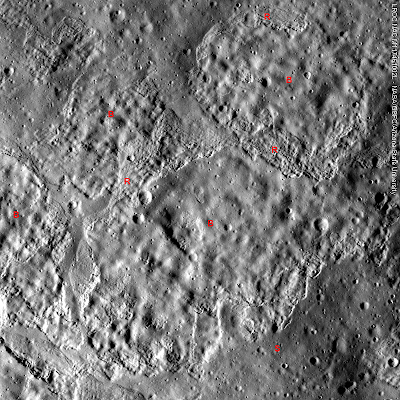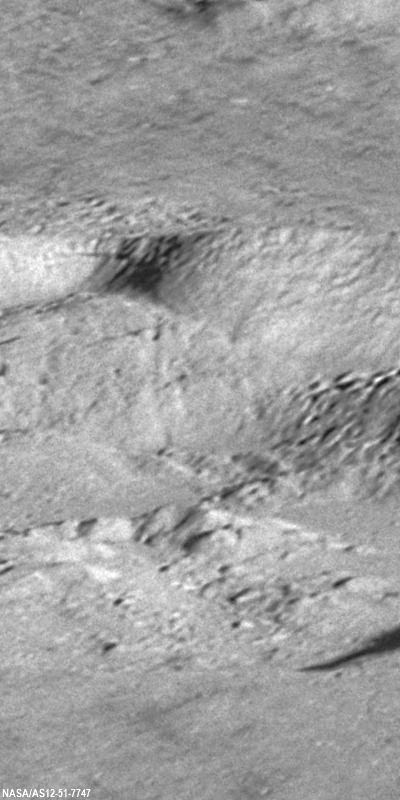Friday, December 31, 2010
More on that second Rupes Recta close-up
Thursday, December 30, 2010
A second NAC cross-section of Rupes Recta


Tuesday, December 28, 2010
Rollback
Thursday, December 23, 2010
Wednesday, December 22, 2010
New Light on the Lunar Poles
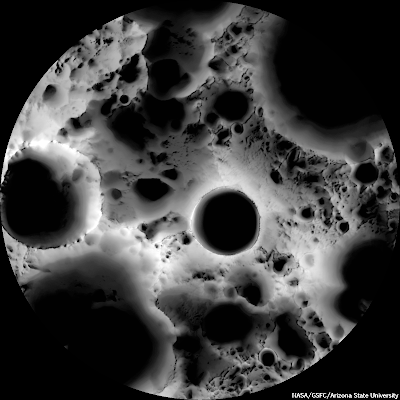 |
| From - From Album LP4 |
A new image released this week by the Lunar Reconnaissance Orbiter Camera Team shows the lighting conditions of the south pole of the Moon. This new data supports the conclusions of many previous studies that areas exist on the Moon that are illuminated by the sun for more than one-half the lunar day (the time it takes the Moon to rotate once on its axis, a bit more than 29 Earth days or about 708 hours).
Why do such areas exist and why are they important? Most locations on the Moon experience a day/night cycle, albeit one of an Earth month duration. But unlike the Earth, the spin axis of the Moon is nearly perpendicular (off from the vertical by 1.5°) to the plane of its orbit around the Sun (the Moon orbits the Earth, but as the Earth orbits the Sun, the Moon can be said to do the same). This means that at the poles, the Sun is always close to the horizon. As the Moon slowly rotates during the course of a lunar day, the Sun tracks a 360° circle around the pole, sometimes just above the horizon, sometimes dipping just below it.
Or rather, it would do that if the Moon were a smooth sphere. But as we all know, the Moon is not smooth – deep craters and basin make rims, peaks and holes that complicate the picture. The deep interiors of craters may never see any sunlight at all. These areas are extremely cold; we’ve learned from new orbital data that some of these cold traps are only a couple of tens of degrees above absolute zero. It is for this reason that we find water ice and other volatiles near the poles – they are stable in the permanently dark, cold areas here.
On the other hand, if some bit of terrain near the pole is topographically high, it may stick up into the sunlight for a much longer time than other spots on the Moon. This concept was first postulated in 1837 by German astronomers Wilhelm Beer and Johann Mädler and popularized in 1879 by French astronomer Camille Flammarion, who dubbed these areas pics de lumière éternelle (peaks of eternal light). If such an area could be found near one of the lunar poles, the only time it would not be in sunlight would be during a lunar eclipse, which occur infrequently and last only a few hours.
We got our first good look at the lunar poles in 1994 with the global mapping obtained by the Clementine spacecraft. Although Clementine only orbited the Moon for 71 days, we were able to determine that no peaks of “eternal light” existed at the south pole. However, we did find small areas near the south pole that are lit more than 70% of the lunar day, and this was during the southern “winter” season (the 1.5° obliquity of the Moon provides some small seasonal variation). We also found locations that are lit 100% of the day at the north pole. These images were taken during mid-summer, when the north pole receives maximum solar illumination.
These areas are extremely cold; we’ve learned from new orbital data that some of these cold traps are only a couple of tens of degrees above absolute zero. It is for this reason that we find water ice and other volatiles near the poles – they are stable in the permanently dark, cold areas here.Lighting at the poles is primarily dependent on local topographic relief. Because Clementine did not get laser topography for latitudes greater than 70°, we had a poor understanding of polar topography until the Japanese Kaguya mission flew in 2008. The Kaguya spacecraft made a detailed laser altimetry map of the entire Moon, including both poles. From this precision topographic data, we made a simulated relief model of the poles and illuminated it as the real Moon would be illuminated by the Sun over the course of a year. Our new results suggest at least four areas near the south pole are in sunlight for large fractions of the lunar day. One location (B) is illuminated more than 82% of the lunar day and is only 10 km from another point (A) that is lit 81% of the day. Moreover, these two points are complementary in that the dark times at one corresponds to sunlit times at the other. The four topographically high sunlight points are collectively illuminated 100% of the time during the lunar seasons.
The new composite image from LROC confirms the inferences from the illumination model we devised from the Kaguya altimetry. The four high points (A-D) correspond to bright zones on the illumination map (see image above), indicating that they are sunlit most of the time. These areas of “quasi-permanent” sunlight are the closest things we have found to correspond to Flammarion’s imagined pics de lumière éternelle. Although not “eternal” in the original sense, they are sunlit for extended periods, well beyond the typical lunar day-night cycle.
What is the significance of such features? Permanently lit areas of the Moon are important for future habitation and use of the Moon for two principal reasons. First, these sunlit areas are prime locations for the establishment of solar photovoltaic arrays. The constant sunlight here means continuous generation of electrical power using solar panels. This solves one of the most difficult problems of lunar habitation, survival during the 354-hour lunar night. Prior to the discovery of the quasi-permanently lit areas, we imagined that the only feasible power source to survive this long night was nuclear reactors. Such a power system does not exist and would require several tens of billions of dollars to develop. So sunlit zones allow us to go to the Moon and stay there without this expense and technology development.
The second advantage of a sunlit area is that it is thermally benign. The surface temperatures at the lunar equator and mid-latitudes depend almost entirely upon incident solar illumination and range from less than -150° to over 100° C, a 250° temperature-swing over the course of a day. In contrast, the surface temperature of these quasi-permanent lit areas is nearly constant – a nice, toasty -50° ± 10° C. This simplifies the thermal design of surface habitats and equipment and greatly relieves the energy required for thermal control at an outpost.
The sunlit areas of the poles occur in close proximity to high concentrations of water ice and other volatiles at the poles of the Moon. Their presence indicates the lunar poles are the best places we have found off-planet for human habitation. Constant sunlight, benign temperatures, near the water and a great view – that’s prime real estate.
Tuesday, December 21, 2010
Can we afford to return to the Moon?
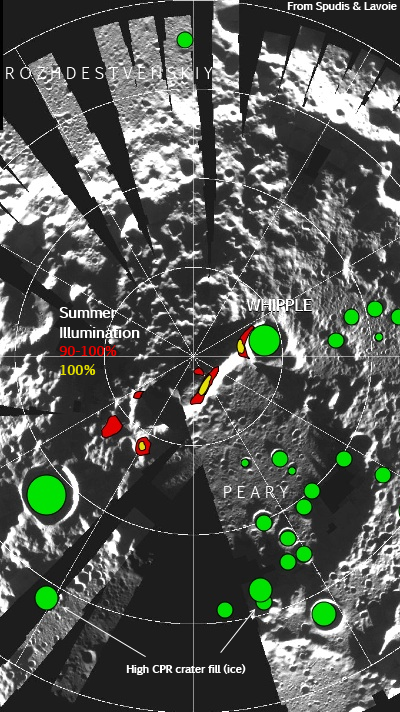 |
| From - From 41st LPSC Album |
Paul D. Spudis
The Once & Future Moon
Smithsonian Air & Space
I take issue with several points in the Augustine report and have commented on them at length in several previous posts of this blog. But now that the dust has settled and we have a “new direction” for our space program, its two principal deficiencies are evident. First, by discarding the clear strategic direction provided by the VSE, we have entered an era of uncertainty and aimlessness of purpose in our space program. This institutional drift is reflected in nearly daily stories about NASA – new missions studies, new launch vehicles, the endless personal backbiting amongst the space internet cognoscenti. Second, the assertion of the report that return to the Moon is “unaffordable” is simply wrong. How you go to the Moon and what your mission is there determines cost and all the committee looked at were cost models for the existing program and minor variants on it.
I have made both of these points here and elsewhere and many were quick to challenge me to show how we could go back to the Moon under the conditions and assumptions of the Augustine committee. Rather than shut up, I now put up. I have submitted a paper for publication in the Proceedings of Space Manufacturing 14, the conference in late October sponsored by the Space Studies Institute. My co-author Tony Lavoie and I have developed an architecture that returns America to the Moon with a specific mission in an affordable way. Our paper has now been accepted for publication, so I am posting a pre-print of it on my web site and will summarize our findings here.
One of the biggest problems with NASA’s implementation of the VSE was that they never understood why we were going to the Moon. I base this assertion on their own statements, actions and publications. Early workshops were held by the agency to develop a rationale for lunar return. The Exploration Directorate issued a poster showing six “themes” for lunar return, but no one at the agency could state their mission in one sentence. At a Congressional hearing in 2009, the acting administrator of NASA said the he did not understand what “return to the Moon” meant in terms of mission objectives and activities.
The agency took the position that they were merely transportation agents – that it was up to the various “user” communities to decide that activities were to be undertaken on the Moon. As a matter of fact, the Vision itself very specifically laid out what was to be done on the Moon and even how to approach it. The purpose of lunar return is to learn the skills and develop the technologies we need to live on another world. The Vision specifically mentions that one skill we need to acquire is the use of extraterrestrial resources to make both exploration and human presence permanent and sustainable.
NASA ignored this direction. There are many reasons why they did this, but I believe that the main one was they did not know how to create sustainable human presence on the Moon using its resources and were concerned that such a thing might not be possible. But building large rockets is certainly possible – history documented that. So the VSE morphed into a rocket-building program, an Apollo Redux because that’s what the agency (allegedly) knew how to do. The only problem was that we do not live in the Apollo era and the space program no longer gets 7% of the federal budget.
The approach we take in our new architecture is to: 1) define the mission clearly and directly; and 2) design an architecture that accomplishes the mission in small, incremental and cumulative steps. These last three adjectives are important: Steps must be small to be affordable, not only under existing budgetary constraints but also under possible lower budgets that could be necessitated by national economic conditions in the future. The steps should be incremental, meaning that each step adds some asset or capability and must work in tandem with previous equipment and operations. Finally, the steps must interlock such that the whole is greater than the sum of the parts. The architecture cumulatively increases features and capabilities with time.
We take as our mission the original Vision for Space Exploration. We go to the Moon to establish a permanent human presence there and a reusable, refuelable, and extensible transportation system to support such presence. Once established, we will have a space faring system that can not only routinely access the Moon, but all other points in cislunar space and beyond, including the L-points and near-Earth asteroids.
How do we accomplish all this? One of the principal advantages of the Moon as our first goal beyond LEO is that: 1) it has the material and energy resources we need; and 2) it is both close and accessible. This latter set of attributes is more important than you might think. The closeness of the Moon allows us to directly control and operate robots on the lunar surface; the time-lag between action on Earth and execution on the Moon is only a bit over one second. We can operate machines on the Moon in near real-time. Additionally, we can send space vehicles to the Moon at virtually any time. No other space destination is so easily and readily accessible.
The key to making all this work is the use of teleoperated robotic machines. We go to the Moon robotically first and later with people. These robots are controlled by people on the Earth. They prospect for resources, test techniques, evaluate product yields, set up processing plants, and begin harvesting lunar resources almost immediately. The extracted products are cached on the surface for future use. The entire lunar outpost is set-up and made operational by these robotic machines.
Our architecture is designed so that time is a free variable. We make constant, steady progress toward our goal; in fiscally lean times, we go slower, but we can accelerate the schedule if more money is available. Making individual steps small and incremental permits this approach – we are not waiting for the development or advent of some “magic carpet” piece of equipment to fill a major hole in our plan.
So what’s the bottom line? Our plan creates a fully functional, operating lunar resource outpost capable of manufacturing 150 metric tonnes of water per year. In addition, we develop a reusable space faring system, one fueled by lunar propellant and expandable to support missions to the planets and destinations throughout cislunar space. We do all of this under the budget guidelines provided to the Augustine committee by NASA; total aggregate funding for this program is less than $88 billion (real-year dollars), with peak funding of $7.1 B in Year 11. Although schedule is flexible, we achieve our primary mission goals by the end of year 16. We have had our assumptions, mass estimates and costing examined, reviewed and validated by a variety of space experts, including the Engineering Directorate Mission Analysis Group at NASA’s Marshall Space Flight Center. This program architecture does what Project Constellation did not: it returns America to the Moon with a legacy of real and permanent space faring infrastructure.
In contrast to the current drift of our space program, the original Vision for Space Exploration set a strategic direction and path that made sense, giving us an expanding sphere of human reach beyond low Earth orbit. The idea that America cannot afford space is ludicrous – we have the world’s largest economy and the amount we spend on space is now less than one-half of one percent of the federal budget. But whatever we spend on space, we should expect to get something in return. A lunar outpost and space transportation system gives us a return on our investment; a program of one-off, stunt missions does not.
The path forward into the future is still open to us.
Friday, December 17, 2010
LRO's unprecedented topography of the Moon
Nancy N. Jones
Goddard Space Flight Center
The Lunar Orbiter Laser Altimeter (LOLA) works by propagating a single laser pulse through a Diffractive Optical Element that splits it into five beams. These beams then strike and are backscattered from the lunar surface. From the return pulse, the LOLA electronics determines the time of flight which, accounting for the speed of light, provides a precise measurement of the range from the spacecraft to the lunar surface. Range measurements, combined with accurate tracking of the spacecraft's location, are used to build a map revealing the contours of the lunar landscape. The five beams create a two-dimensional spot pattern that unambiguously reveals slopes. LOLA will also measure the spreading of the return pulse to get the surface roughness and the change in the transmitted compared to the return energy of the pulse to determine surface reflectance.
"Recent papers have clarified some aspects of lunar processes based solely on the more precise topography provided by the new LOLA maps," adds Neumann, "such as lunar crater density and resurfacing by impacts, or the formation of multi-ring basins."
"The LOLA data also allow us to define the current and historical illumination environment on the moon," said Neumann. Lunar illumination history is important for discovering areas that have been shaded for long periods. Such places, typically in deep craters near the lunar poles, act like cold storage, and are capable of accumulating and preserving volatile material like water ice.
The landscape in polar craters is mysterious because their depths are often in shadow. The new LOLA dataset is illuminating details of their topography for the first time. "Until LRO and the recent Japanese Kaguya mission, we had no idea of what the extremes of polar crater slopes were," said Neumann. "Now, we find slopes of 36 degrees over several kilometers (several thousands of yards) in Shackleton crater, for example, which would make traverses quite difficult and apparently causes landslides. The LOLA measurements of shadowed polar crater slopes and their surface roughness take place at scales from lander size to kilometers. These measurements are helping the LRO science team model the thermal environment of these craters, and team members are developing temperature maps of them."
LRO and LOLA were built and are managed by NASA Goddard. The research was funded by NASA's Exploration Systems Mission Directorate at NASA Headquarters in Washington.
Thursday, December 16, 2010
Chang'e-1 maps Moon's Helium-3 inventory
Fudan University &
Institut de Physique du Globe de Paris
Helium-3 (3He) implanted by solar wind in the lunar regolith is a valuable resource because of its potential as a fusion fuel. On the basis of the Apollo regolith samples, a linear relationship between 3He abundance and solar wind flux, optical maturity and TiO2 content has been presented. China successfully launched its first lunar exploration satellite Chang-E 1 (CE-1) on October 24, 2007. A multi-channeled microwave radiometer was aboard the satellite with the purpose of measuring microwave thermal emission from the lunar surface layer. From the multi-channel brightness temperature (Tb) observed by CE-1, the global distribution of the regolith thickness was inverted from the multi-channel Tb, and was used to evaluate the total amount of 3He per unit area in the lunar regolith. The global inventory of 3He was estimated as being 6.6×108 kg; 3.7×108 kg for the lunar nearside and 2.9×108 kg for the lunar farside.
Helium-3 (3He) is a clean, safe and non-radioactive fusion fuel. Compared with traditional fusion reaction of using 3H, the reaction involving 3He does not generate any high-energy neutrons and does not produce prolonged radioactivity, and hence is not dangerous to a reactor or the environment.
Terrestrial sources of 3He are extremely rare and the total inventory is only about 2.0×104 kg. Because there is neither a geomagnetic field nor an atmosphere on the Moon, solar wind particles can impinge directly upon the lunar surface and hence be captured by lunar regolith particles. As a consequence, a significant amount of solar wind elements (such as helium) have accumulated in the regolith during the long geological history of the Moon.
Significant work has been done to estimate the 3He implantation and abundance in the lunar regolith during the last few decades, based on the returned regolith samples from the Apollo and Luna missions. However, there has been a need to have a precise lunar regolith thickness distribution map of the whole lunar surface to determine the quantities of 3He present.
China successfully launched its first lunar exploration satellite Chang-E 1 (CE-1) on October 24, 2007. A multichannel microwave radiometer was aboard the satellite and had the purpose of measuring microwave thermal emissions from the lunar surface layer. From the analysis of the primary CE-1 observations, consisting of the brightness temperature (Tb) (from November 2007 to February 2008), Fa and Jin successfully inverted the global distribution of regolith thickness. This newly acquired dataset provided an opportunity to quantitatively estimate the global inventory of the 3He accumulated in the whole regolith.
In this study, by combining the models of normalized solar wind flux over the lunar surface, the global distribution of TiO2 content and the surface optical maturity derived from Clementine UVVIS multi-spectral data, a linear relationship between 3He abundance, TiO2 content and surface optical maturity can be derived for the global distribution of 3He in the lunar near-surface layer (thickness less than 1 μm). Using the newly acquired global distribution of the regolith thickness obtained from CE-1 multi-channel radiometer observations, the total amount of 3He per unit area in lunar regolith can then be obtained.
Monday, December 13, 2010
The Pioneer lunar orbiters: a forgotten failure
Andrew J. LaPage
The Space Review
Before NASA was founded on October 1, 1958, the US Air Force had ambitious plans for space exploration. During the national debate that followed the launch of Sputnik, the Air Force was trying to position itself so that it could dominate the nation’s infant space program. Even after the Advanced Research Projects Agency (ARPA) was founded in February of 1958 and was given the task of coordinating America’s military space programs, Air Force efforts and plans figured prominently.
By the fall of 1959, the Able combination along with its cousin, the Vanguard upper stages, had an abysmal performance record.The Air Force’s first step beyond Earth orbit, called Project Able, was a series of attempts to place a small spacecraft into orbit around the Moon. These orbiters, along with a pair of small US Army-JPL lunar flyby probes, were part of the ARPA-sponsored Operation Mona, which was approved by President Dwight Eisenhower on March 27, 1958. Three launch attempts made by the Air Force between August and November of 1958, now called Pioneers 0, 1, and 2; all failed to reach the Moon. But even before these missions flew, the Air Force, in conjunction with the builders of their first lunar orbiters, STL (Space Technology Laboratory, a division of TRW), began to study follow-on missions not only to lunar orbit but also to Venus, given priority. Little was known about Earth’s near twin at this time and many believed Venus ranked with Mars as a likely abode for extraterrestrial life, making it a desirable target for exploration.
Friday, December 10, 2010
Impact melt features of Tycho's floor
Drew Enns
LROC News System
Can you find more impact melt features in the NAC frame?
Related Posts:
The Floor of Tycho - Constellation ROI
Thursday, December 9, 2010
Ejecta on the slumped inner wall of Tycho
Drew Enns
LROC News System
Explore the impact melt within Tycho's inner walls in the full LROC NAC image.
Related Posts:
Impact melt at Necho crater
Natural Bridge on the Moon
Monday, December 6, 2010
The Space Review: Apollo secrets & whispers
Dwayne A. Day
The Space Review
The existence of the Lunar Mapping and Survey System was not classified, and actually appeared in an open source publication, a space encyclopedia aimed at kids that was produced in the later 1960s.
Friday, December 3, 2010
Rilles as far as the eye can see at Prinz
Lillian Ostrach
LROC News Service
Related posts
Rimae Prinz Region - Constellation ROI
Rimae Posidonius
Secrets of Schröteri
Thursday, December 2, 2010
Secrets of Schröteri
Lillian Ostrach
LROC News System
No matter how often the Aristarchus Plateau is imaged, and we have presented a wide variety of such images here, as seen in different wavelengths and bands from Earth and from lunar orbit, every new opportunity seems to show a new face to this feature, unique in our star system. Above the Kaguya HDTV still shows two perspectives of the LROC Wide Angle Camera mosaic attached to the digital elevation model of the Moon available in Google Earth. Besides the valley, where details are obscured in these greatly reduced images, is the crater Herodotus, the far older sister of Aristarchus.
Related posts:
Aristarchus Plateau 1: Amazing Geologic Diversity
Rille within a rille!
The Great Wall of Aristarchus
The colorful Moon
LROC: Aristarchus - Up from the Depths
LOLA's Aristarchus Plateau
Wednesday, December 1, 2010
Rimae Posidonius
Lillian Ostrach
LROC News System
 Sinuous rilles are remarkable features resulting from turbulent flow of low viscosity (very fluid), high temperature lavas that erodes the pre-existing surface. In turbulent fluid flows, eddies and vortices form that can be highly erosive and result in the twists and turns seen in many rilles. This rille, located on the western edge of Posidonius crater (~100 km diameter, floor-fractured and partially mare-filled), tightly winds against the northern crater wall and then veers away in a southerly course.
Sinuous rilles are remarkable features resulting from turbulent flow of low viscosity (very fluid), high temperature lavas that erodes the pre-existing surface. In turbulent fluid flows, eddies and vortices form that can be highly erosive and result in the twists and turns seen in many rilles. This rille, located on the western edge of Posidonius crater (~100 km diameter, floor-fractured and partially mare-filled), tightly winds against the northern crater wall and then veers away in a southerly course.What do you think is most scientifically fascinating about sinuous rilles? Discover the winding turns of this sinuous rille in the LROC WAC mosaic and in the full LROC NAC image!
Related posts:
Marius Hills
Aristarchus Plateau 1: Amazing Geologic Diversity
Rille within a rille!
Wednesday, November 24, 2010
Erosional troughs on crater wall
Jeff Plescia
LROC News System
 A number of erosional troughs are observed on the inner wall of Moore F on the lunar far side (37.21°N, 185.48°E). The crater is 23.7 km in diameter and is relatively fresh, as evidenced by bright ejecta and its pristine morphology. Numerous troughs are observed extending down the inner crater wall. The feature shown here is the freshest with a smooth floor composed of bright material.
A number of erosional troughs are observed on the inner wall of Moore F on the lunar far side (37.21°N, 185.48°E). The crater is 23.7 km in diameter and is relatively fresh, as evidenced by bright ejecta and its pristine morphology. Numerous troughs are observed extending down the inner crater wall. The feature shown here is the freshest with a smooth floor composed of bright material.The trough is about 810 meters long and around 140 meters wide near its head, narrowing slightly to about 105 m in the middle before widening to some 200 meters.
Explore the full NAC image.
Check out a related post!
Monday, November 22, 2010
Delicate patterns in Giordano Bruno ejecta
Hiroyuki Sato
LROC News System
Explore the Giordano Bruno ejecta blanket NAC frame!
Reference: Lucey et al. (2000) JGR, v105, no. E8, p.20377-20386.
Previous post showing the floor of Giordano Bruno.
Thursday, November 18, 2010
Avalanche in Robinson crater
Hiroyuki Sato
LROC News System
Explore lunar landslides by viewing the full NAC frame!
Similar slides can be seen in a small crater in the center of crater Henry Frères.
Tuesday, November 16, 2010
Slope failure near Aratus
Hiroyuki Sato
LROC News System
Estimates of sliding layer thickness, local topography, and morphological characterization of flow features allow scientists to determine the geotechnical (soil mechanics) properties of the lunar regolith. Such studies are key to designing future rovers, space suits, and tools for exploring the Moon.
Explore lunar landslides by viewing the full NAC frame.
Friday, November 12, 2010
The Central Peak of Kepler
Drew Enns
LROC News Service

Browse the whole NAC image of Kepler crater and inspect the landforms associated with its central peak. Can you find evidence of impact melt on the central peak, terraces, and floor?
Related Posts:
Concentric crater
Kepler Crater Ejecta
Kepler's Rim








